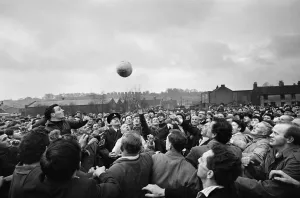
The town of Ashbourne in Derbyshire, England, transforms into a bustling arena of chaos and camaraderie each year for the Royal Shrovetide Football match. This ancient spectacle, a captivating blend of tradition and mayhem, attracts thousands of spectators, eager to witness a game that defies modern sporting conventions. Played annually on Shrove Tuesday and Ash Wednesday, the Shrovetide match is not just a game; it’s a cultural phenomenon steeped in history and local pride.

The origins of the Shrovetide match can be traced back to the 12th century, making it one of the oldest forms of football in the world. The game is a vivid reminder of a time when football had no standardized rules and was characterized by its free-for-all nature. The only rules that govern this medieval melee are surprisingly straightforward yet pertinent: no murder or manslaughter. As reported by AP News, these rules are a nod to the game's past when such guidelines were necessary to maintain some semblance of order amidst the chaos.
The match features two teams: the Up'ards and the Down'ards, representing the two halves of Ashbourne town, divided by the Henmore Brook. The objective is simple yet challenging: to carry the ball to a goal located several miles apart from each other. The Up'ards aim to get the ball to the upstream goal at Sturston Mill, while the Down'ards target the downstream goal at Clifton Mill. The 'goals' are not traditional goalposts but are rather stone markers, and scoring involves tapping the ball three times against the millstones.

The game starts when the ball, a beautifully painted leather sphere, is ceremonially 'turned up' at Shaw Croft car park, the traditional starting point. From there, pandemonium ensues as hundreds of players surge forward, jostling and wrestling for possession. The ball can be carried, thrown, or kicked, and the play area spans the entire town and the surrounding countryside. The game is played over two eight-hour periods across the two days, with the match pausing at 10 p.m. each night.
The Shrovetide match is a community affair, bringing together townspeople of all ages and backgrounds. Players don a mix of soccer and rugby jerseys, and the atmosphere is both festive and fierce. The town is adorned with bunting, and local businesses close early to accommodate the influx of participants and spectators. For many, it's a family tradition, passed down through generations, with children often seen clambering up trees or perched on parents' shoulders to get the best view of the action.

Despite the apparent chaos, the game is played with a remarkable sense of sportsmanship and respect for tradition. It’s not uncommon for players to pause and help an opponent in distress, or for the entire game to come to a halt to ensure the safety of participants. Spectators, too, play a crucial role, acting as informal referees and ensuring that the rules, however minimal, are upheld.
The appeal of the Shrovetide match extends beyond the spectacle itself. For Ashbourne, it is a celebration of community spirit and identity, an event that unites the town in a unique and exhilarating way. As noted by local historian Wakefield, a former reporter on the event, the Shrovetide match is "a spectacle" that captivates both first-time onlookers and seasoned participants alike. It’s a game that embodies the beauty and complexity of Ashbourne’s heritage, drawing people back year after year.
While the Shrovetide match might be bewildering to outsiders, for those who call Ashbourne home, it is a cherished tradition, a testament to the enduring allure of a game that has stood the test of time. It’s a reminder that in the world of football, sometimes the greatest drama unfolds not in the stadiums of the Premier League or the World Cup but in the muddy fields and narrow streets of a small English town.
For those fortunate enough to witness the Shrovetide match, it offers a glimpse into a bygone era of football, where the game is as much about community and camaraderie as it is about competition. As the ball is tossed into the throng of players each year, the spirit of Ashbourne comes alive, proving that some traditions, however chaotic, are indeed timeless.